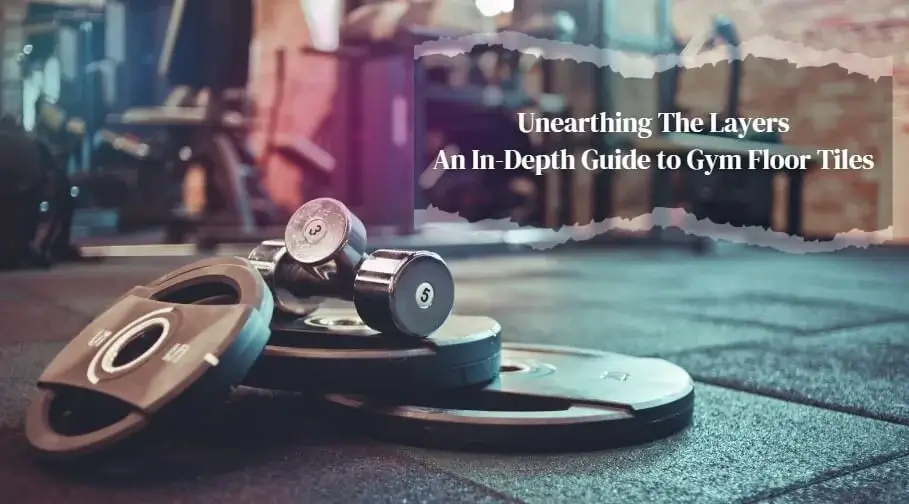Table of Contents
Gym Enthusiasts’ Unsung Hero – Gym Floor Tiles
To the uninitiated, all gym floors may seem the same. However, anyone familiar with the intricacies of fitness understands the pivotal role played by gym floor tiles. Beyond aesthetics, these tiles dictate safety, functionality, and the overall vibe of the workout environment. When walking into a gym, it’s not just the machinery or the trainers that can make a difference. The floor beneath your feet, often taken for granted, is engineered to ensure you get the best out of your exercise routine without compromising on your safety. From shock absorption to providing grip, these tiles are the silent supporters of your fitness journey.
Types of Gym Floor Tiles
Not every tile is created equal. Depending on the exercises, equipment, and aesthetic fitness goals, the type of gym floor tiles chosen can differ:
- Rubber Tiles: Robust and resilient, these tiles are ideal for weightlifting zones, absorbing the shock of heavy weights. Their dense material provides superior floor protection and reduces vibration, making them a staple in many professional gym setups.
- Foam Tiles: Soft and cushioned, they’re excellent for low-impact workouts, yoga, or Pilates. Apart from being gentle on the joints, they also have thermal insulation properties, making your floor feel warmer during those cold morning workouts.
- Vinyl Tiles: These provide a smooth surface that’s easy to clean, making them a popular choice for general-purpose gyms. They’re resistant to water and stains, ensuring longevity and ease of maintenance.
- Turf Tiles: Perfect for those wanting a grassy texture, they’re great for agility drills and functional training exercises. Mimicking natural turf, they provide an optimal surface for sled pushes and athletic training.
The Importance of Gym Floor Tiles
Many overlook the significance of gym floor tiles, but their impact is multifaceted:
- Safety: They offer a non-slip surface, reducing the risk of accidents. Imagine doing a high-intensity workout on a slippery surface; it’s an accident waiting to happen. Proper flooring provides traction and ensures stability.
- Equipment Protection: Quality tiles minimize damage to gym equipment. Dropping weights on a hard surface not only damages the floor but also the equipment. With the right tiles, the impact is dispersed, saving your costly gear.
- Noise Absorption: Tiles, especially thicker varieties, can help muffle the noise of dropped weights and high-impact exercises. This noise reduction is crucial, especially in home gyms or apartment complexes, to not disturb the neighbors.
Maintenance and Upkeep
While gym floor tiles are designed to withstand the test of time, regular maintenance ensures they remain in pristine condition:
- Cleaning: A simple mix of mild detergent and water usually suffices. Regular cleaning prevents the buildup of dirt and bacteria, promoting a hygienic workout environment.
- Replacement: Over time, sections may wear out and need replacing. Thankfully, tiles make this process seamless. Instead of redoing the entire floor, you can replace only the worn-out tiles, saving time and money.
Read Also: World Gym San Diego Reviews
Selecting the Right Tiles for Your Gym
Before investing, consider:
- Purpose: A yoga studio has different needs from a powerlifting zone. Identify the primary activities to select the optimal flooring.
- Budget: From basic to premium, tiles cater to various price ranges. Investing a bit more upfront can lead to long-term savings, given the durability of higher-end tiles.
- Aesthetics: The look and feel can significantly influence the gym’s ambiance. While functionality is paramount, the aesthetic appeal sets the mood and enhances motivation.
Conclusion:
Gym floor tiles may be underfoot, but their importance shouldn’t be underestimated. They safeguard users, equipment, and play a pivotal role in defining a gym’s character. As the fitness industry evolves, the emphasis on proper flooring has grown, showing that a gym’s foundation is just as crucial as the advanced equipment it houses.
FAQs
Why are Gym Floor Tiles Essential?
They ensure safety, protect equipment, and contribute to the gym’s ambiance.
How Often Should I Clean my Gym Tiles?
Regular cleaning, at least once a week, is recommended, though this can vary based on foot traffic.
Can Gym Floor Tiles be Replaced Individually?
Yes, the beauty of tiles is that you can replace them individually if one gets damaged.
Which tile is Best for Heavy Weightlifting Areas?
Rubber tiles, due to their robust and shock-absorbent nature, are ideal for weightlifting zones.

